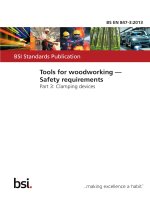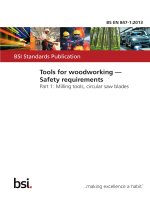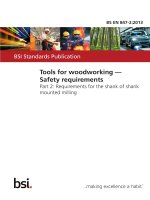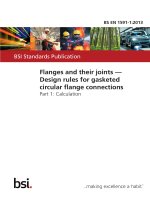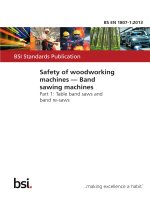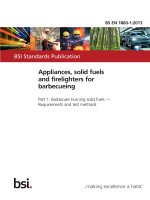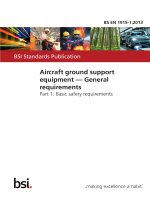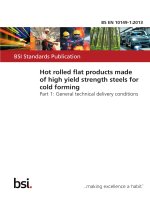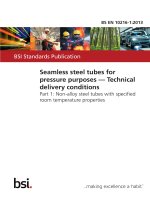Bsi bs en 00847 1 2013
Bạn đang xem bản rút gọn của tài liệu. Xem và tải ngay bản đầy đủ của tài liệu tại đây (1.11 MB, 40 trang )
BS EN 847-1:2013
BSI Standards Publication
Tools for woodworking —
Safety requirements
Part 1: Milling tools, circular saw blades
BS EN 847-1:2013
BRITISH STANDARD
National foreword
This British Standard is the UK implementation of EN 847-1:2013. It
supersedes BS EN 847-1:2005 which is withdrawn.
The UK participation in its preparation was entrusted to Technical
Committee MTE/23, Woodworking machines.
A list of organizations represented on this committee can be
obtained on request to its secretary.
This publication does not purport to include all the necessary
provisions of a contract. Users are responsible for its correct
application.
© The British Standards Institution 2013. Published by BSI Standards
Limited 2013
ISBN 978 0 580 75762 4
ICS 79.120.10
Compliance with a British Standard cannot confer immunity from
legal obligations.
This British Standard was published under the authority of the
Standards Policy and Strategy Committee on 31 October 2013.
Amendments issued since publication
Date
Text affected
BS EN 847-1:2013
EN 847-1
EUROPEAN STANDARD
NORME EUROPÉENNE
EUROPÄISCHE NORM
October 2013
ICS 79.120.10
Supersedes EN 847-1:2005+A1:2007
English Version
Tools for woodworking - Safety requirements - Part 1: Milling
tools, circular saw blades
Outils pour le travail du bois - Prescriptions de sécurité Partie 1: Outils de fraisage, lames de scies circulaires
Maschinen-Werkzeuge für Holzbearbeitung Sicherheitstechnische Anforderungen - Teil 1: Fräs- und
Hobelwerkzeuge, Kreissägeblätter
This European Standard was approved by CEN on 10 August 2013.
CEN members are bound to comply with the CEN/CENELEC Internal Regulations which stipulate the conditions for giving this European
Standard the status of a national standard without any alteration. Up-to-date lists and bibliographical references concerning such national
standards may be obtained on application to the CEN-CENELEC Management Centre or to any CEN member.
This European Standard exists in three official versions (English, French, German). A version in any other language made by translation
under the responsibility of a CEN member into its own language and notified to the CEN-CENELEC Management Centre has the same
status as the official versions.
CEN members are the national standards bodies of Austria, Belgium, Bulgaria, Croatia, Cyprus, Czech Republic, Denmark, Estonia,
Finland, Former Yugoslav Republic of Macedonia, France, Germany, Greece, Hungary, Iceland, Ireland, Italy, Latvia, Lithuania,
Luxembourg, Malta, Netherlands, Norway, Poland, Portugal, Romania, Slovakia, Slovenia, Spain, Sweden, Switzerland, Turkey and United
Kingdom.
EUROPEAN COMMITTEE FOR STANDARDIZATION
COMITÉ EUROPÉEN DE NORMALISATION
EUROPÄISCHES KOMITEE FÜR NORMUNG
CEN-CENELEC Management Centre: Avenue Marnix 17, B-1000 Brussels
© 2013 CEN
All rights of exploitation in any form and by any means reserved
worldwide for CEN national Members.
Ref. No. EN 847-1:2013: E
BS EN 847-1:2013
EN 847-1:2013 (E)
Contents
Page
Foreword ..............................................................................................................................................................4
Introduction .........................................................................................................................................................5
1
Scope ......................................................................................................................................................6
2
Normative references ............................................................................................................................6
3
3.1
3.2
Terms, definitions, symbols and abbreviations .................................................................................6
Terms and definitions ...........................................................................................................................6
Symbols and abbreviations ............................................................................................................... 12
4
List of significant hazards ................................................................................................................. 14
5
5.1
5.1.1
5.1.2
5.1.3
5.1.4
5.1.5
5.1.6
5.1.7
5.2
5.2.1
5.2.2
5.2.3
Design requirements .......................................................................................................................... 15
General requirements for milling tools and circular saw blades ................................................... 15
General ................................................................................................................................................. 15
Safety requirements and/or measures ............................................................................................. 15
Separable fixing .................................................................................................................................. 16
Overspeed type test for complex tools ............................................................................................ 17
Cutting blade thickness and cutting blade projection .................................................................... 18
Dimensions and tolerances ............................................................................................................... 19
Handling of detachable tools with m > 15 kg ................................................................................... 20
Specific requirements for milling tools ............................................................................................ 20
Tools for hand fed machines ............................................................................................................. 20
Prevention of relative rotation within a tool combination .............................................................. 26
Balance of milling tools ..................................................................................................................... 26
6
6.1
6.3
6.4
6.5
6.6
Tool identification ............................................................................................................................... 28
Marking of milling tools for integrated feed other than shank mounted tools or integrated
tools ..................................................................................................................................................... 28
Marking of milling tools for machines with hand feed other than shank mounted tools or
integrated tools ................................................................................................................................... 28
Marking of integrated tools ................................................................................................................ 28
Marking of shank mounted tools ...................................................................................................... 29
Marking of circular saw blades ......................................................................................................... 29
Marking of cutting parts and deflectors ........................................................................................... 30
7
7.1
7.2
7.2.1
7.2.2
7.2.3
7.2.4
7.2.5
7.3
7.4
Information for use ............................................................................................................................. 30
General ................................................................................................................................................. 30
Safe working practice ......................................................................................................................... 30
Maximum speed .................................................................................................................................. 30
Circular saw blades ............................................................................................................................ 30
One piece tools ................................................................................................................................... 30
Cleaning ............................................................................................................................................... 30
Mounting and fastening of tools and tool parts .............................................................................. 31
Maintenance of tools .......................................................................................................................... 31
Handling ............................................................................................................................................... 32
Annex
A.1
A.2
A.3
A.4
A.5
A.6
A.7
A (informative) Maintenance and modification of milling tools and related components ............ 33
General ................................................................................................................................................. 33
Minimum dimensions ......................................................................................................................... 33
Retipping, exchange of tips on composite tools and circular saw blades ................................... 33
Milling tools marked with MAN.......................................................................................................... 33
Balance of milling tools ..................................................................................................................... 33
Marking ................................................................................................................................................ 33
Information .......................................................................................................................................... 33
6.2
2
BS EN 847-1:2013
EN 847-1:2013 (E)
Annex B (normative) Palmqvist Toughness Test .......................................................................................... 34
Bibliography ...................................................................................................................................................... 35
3
BS EN 847-1:2013
EN 847-1:2013 (E)
Foreword
This document (EN 847-1:2013) has been prepared by Technical Committee CEN/TC 142 “Woodworking
machines - Safety”, the secretariat of which is held by UNI.
This European Standard shall be given the status of a national standard, either by publication of an identical
text or by endorsement, at the latest by April 2014, and conflicting national standards shall be withdrawn at the
latest by April 2014.
Attention is drawn to the possibility that some of the elements of this document may be the subject of patent
rights. CEN [and/or CENELEC] shall not be held responsible for identifying any or all such patent rights.
This document supersedes EN 847-1:2005+A1:2007.
The following table contains a list of modifications from the previous edition.
EN 847-1:2005+A1:2007
EN 847-1:2013
Reason
3 Terms
3 Terms and definitions
editorial (ed)
4 Symbols and abbreviations
3.2 Symbols and abbreviations
ed
5 List of significant hazards
4 List of significant hazards
ed
6 Design requirements
5 Design requirements
ed
6.2.3.2.2 Balance quality requirements
5.2.3.2 Balance quality requirements
ed
Table 4 (5): 3 columns
Table 5: 4 columns
Precision of
requirements (te)
New Table 6: Quantities and units
ed
7 Tool identification
6 Tool identification
ed
8 Information for use
7 Information for use
ed
Annex A: Safe work practice
7.2 Safe working practice
ed
Annex B: Maintenance and modification
of milling tools and related components
Annex A: Maintenance and modification
of milling tools and related components
ed
Annex C: Palmqvist toughness test
Annex B: Palmqvist toughness test
ed
According to the CEN-CENELEC Internal Regulations, the national standards organisations of the following
countries are bound to implement this European Standard: Austria, Belgium, Bulgaria, Croatia, Cyprus, Czech
Republic, Denmark, Estonia, Finland, Former Yugoslav Republic of Macedonia, France, Germany, Greece,
Hungary, Iceland, Ireland, Italy, Latvia, Lithuania, Luxembourg, Malta, Netherlands, Norway, Poland, Portugal,
Romania, Slovakia, Slovenia, Spain, Sweden, Switzerland, Turkey and the United Kingdom.
4
BS EN 847-1:2013
EN 847-1:2013 (E)
Introduction
The extent to which hazards are covered is indicated in the Scope of this document.
The requirements of this document concern designers, manufacturers, suppliers and importers of tools for
woodworking.
This document also includes information which the manufacturer will provide to the user.
5
BS EN 847-1:2013
EN 847-1:2013 (E)
1
Scope
This European Standard specifies all hazards arising from the use of tools for woodworking machines, and
describes the methods for the elimination or reduction of these hazards by tool design and by the provision of
information. This European Standard deals with milling tools (bore mounted, shank mounted), integrated tools
and circular saw blades.
This European Standard does not cover any hazard related to the strength of shank of shank mounted milling
tools. The hazards are listed in Clause 4. This European Standard does not apply to boring bits, eccentric
single router cutters, cutters with cutting circle less than 16 mm and to tools used in rotary knife lathes and
copying lathes where the hazard of ejection and contact with the tool is always prevented by a system of fixed
guards and/or movable guards interlocked with guard-locking and/or self-closing guards.
2
Normative references
The following documents, in whole or in part, are normatively referenced in this document and are
indispensable for its application. For dated references, only the edition cited applies. For undated references,
the latest edition of the referenced document (including any amendments) applies.
EN 847-2, Tools for woodworking — Safety requirements — Part 2: Requirements for the shank of shank
mounted milling
EN 23878, Hardmetals — Vickers hardness test (ISO 3878)
ISO 286-2, Geometrical product specifications (GPS) — ISO code system for tolerances on linear sizes —
Part 2: Tables of standard tolerance classes and limit deviations for holes and shafts
ISO 1940-1, Mechanical vibration — Balance quality requirements for rotors in a constant (rigid) state —
Part 1: Specification and verification of balance tolerances
3
3.1
Terms, definitions, symbols and abbreviations
Terms and definitions
For the purposes of this document, the following terms and definitions apply.
3.1.1
milling tools
rotating cutting tool (e.g. milling cutter, planing cutter, thicknessing cutter) normally having its main feed
direction perpendicular to the rotation axis, for working various surfaces on wood and similar materials through
chip removal
Note 1 to entry:
The cutting edge of the cutting part may be
parallel to the axis of rotation,
square to the axis of rotation, or
a profile which is a combination of the two.
The tool may be
a one piece tool,
a composite tool,
6
BS EN 847-1:2013
EN 847-1:2013 (E)
a complex tool, or
in the form of a tool set.
3.1.2
circular saw blade
rotating cutting tool for cross-cutting or ripping wood and similar materials through chip removal
Note 1 to entry:
The tools cut on the periphery and on both flanks simultaneously, and may be
a one piece tool,
a composite tool, or
a complex tool.
3.1.3
one piece tool (solid tool)
tools without bonded or detachable parts: the body and the cutting parts are one piece
3.1.4
composite tool (tipped tool)
tools where the cutting parts (tips) are firmly connected by bonding to the body, e.g. welding, brazing,
adhesive fixing
3.1.5
complex tool
tools where one or more cutting parts (inserts, blades) are exchangeably mounted in a body through
detachable fixing elements
Note 1 to entry:
The cutting parts may be one piece or composite.
3.1.6
tool set
number of individual tools clamped together on a tool carrier designed to function as one tool
3.1.7
integrated tools
tools where the body is part of the machine and only the cutting parts are exchangeable
3.1.8
body
part of the tool which holds the cutting blades or inserts, or on which the cutting parts are formed
[SOURCE: ISO 3002-1:1982, 3.2.1]
3.1.9
cutting part
functional part or parts of the tool each comprised of chip producing elements
Note 1 to entry:
The cutting edges, face and flank are therefore elements of the cutting part. In the case of a multitoothed cutter, each tooth has a cutting part.
[SOURCE: ISO 3002-1:1982, 3.2.5]
3.1.10
auxiliary cutting parts
auxiliary cutting parts are additional cutting parts with a cutting width of less than or equal to 12 mm and a
radial cutting edge projection to the body of less than or equal to 13 mm
EXAMPLE
Grooving inserts, bevelling inserts, chamfering inserts.
7
BS EN 847-1:2013
EN 847-1:2013 (E)
3.1.11
spur
cutting part which operates both on its periphery and on its flank
Note 1 to entry:
The spur projects from the major cutting edge in radial, and if applicable, in axial direction. A spur is
either a separate cutting part (see Figure 1) or a part of the major cutting edge.
Dimensions in millimetres
Key
1
screw at the choice of the manufacturer
Figure 1 — Milling tool with a spur
3.1.12
cutting diameter
d1 (cutting radius r1)
for tools where various blades can be mounted, the cutting diameter d1 (cutting radius r1) is the maximum
possible value
Note 1 to entry:
a
See Figure 2.
Shaded area (see 5.2.1.2)
Figure 2 — Cutting diameter and cutting width
8
BS EN 847-1:2013
EN 847-1:2013 (E)
3.1.13
cutting width
b1
for tools where various blades can be mounted, the cutting width b1 is the maximum possible value
Note 1 to entry:
See Figure 2.
3.1.14
deflector
projecting part exchangeably mounted or firmly connected by bonding to the body or part of the body which
performs chip thickness limitation
Note 1 to entry:
The deflector can also be called a "counter-knife".
Note 2 to entry:
See Figures 3 b), c), d), e) and g).
3.1.15
cutting blade projection
t
difference between the radius r1 of the cutting circle and the radius r5 of the back supporting circle where
t = r1 – r5
Note 1 to entry:
See Figure 3.
3.1.16
radial cutting edge projection
cr
difference between the deflector (not round form tools) or the body (round form tools) and the cutting edge
measured in the direction of the normal to the profile
Note 1 to entry:
See Figures 2 and 3.
3.1.17
axial cutting edge projection
ca
distance measured axially between the axial cutting edge and the body or the deflector
Note 1 to entry:
See Figure 3 a) and Figure 3 d).
3.1.18
round form tool
tool where the body has a circular shape in any cross section perpendicular to the rotational axis of the tool
and which performs chip thickness limitation
Note 1 to entry:
Auxiliary cutting parts with a deflector or spurs (see 3.1.10 and 3.1.11) are not considered.
Note 2 to entry:
See Figures 3 a) and 5.
3.1.19
not round form tool
tool where chip thickness limitation is performed by a deflector (see Figures 3 b), c), d), e) and g)) or where a
cross section of the body is not circular
Note 1 to entry:
See Figure 3 f).
3.1.20
round form tool set
functional unit consisting of a number of individual not round form and/or round form tools clamped together
and forming a round form tool shape with radial gaps of less than 5 mm and axial gaps less than 15 mm and
the top and the bottom side is a full round
9
BS EN 847-1:2013
EN 847-1:2013 (E)
3.1.21
tool combination
unit consisting of a number of loose tools connectable in a variable sequence or extendable in a variable
position
3.1.22
non-separable fixing
bonding of the tool components to the body which prevents their change of position relative to each other
3.1.23
separable fixing
fixing of the tool components to the body which allows their change of position relative to each other
3.1.23.1
friction lock fixing
fixing where the relative change of position in a radial direction during rotation is prevented only by the friction
forces
Note 1 to entry:
See Figure 4.
3.1.23.2
form lock fixing
fixing where the relative change of position in the radial direction during rotation is prevented by the form and
arrangement of the components
Note 1 to entry:
See Figure 5.
3.1.24
radial and axial approach flats
flat on the radial and/or axial surface of the deflector or of the body, in front of the deflector edge
Note 1 to entry:
See Figure 6.
3.1.25
radial approach angle
τr
angle between the approach flat and the tangent to the deflector circle at the deflector edge or to the body
circle at the point where the radial approach flat begins
Note 1 to entry:
See Figure 6.
3.1.26
axial approach angle
τa
angle between a plane perpendicular to the axis of the tool and the axial approach flat
Note 1 to entry:
See Figure 6.
3.1.27
basic number of teeth
number of teeth cutting in each part of the profile
3.1.28
woodworking machine
machine or a combination of machines intended for machining of wood and similar materials (see 3.1.29) by
chip removal, or chipless cutting, sanding and forming, laminating (including gluing and edging) or joining
10
BS EN 847-1:2013
EN 847-1:2013 (E)
3.1.29
similar materials
materials with physical and technological characteristics similar to those of wood, such as cork, bone, plastics,
light alloys, wood based materials as chipboard, fibreboard, plywood, etc. and for which the process for
machining and chip or particle removal is similar
3.1.30
tools
all individual tools and tool sets for the mechanical removal of chips e.g. circular saw blades, bandsaw blades,
milling cutters, chain cutters. Tools also include devices for forming and shaping or chipless cutting
3.1.31
hand feed
manual holding and/or guiding of the workpiece or of a machine element incorporating a tool
Note 1 to entry:
Hand feed includes the use of hand-operated carriage on which the workpiece is placed manually or
clamped and the use of demountable power feed unit (see 3.1.36).
3.1.32
integrated feed
feed mechanism for the workpiece or tool which is integrated with the machine and where the workpiece or
machine element with incorporated tool is held and controlled mechanically during the machining operation
3.1.33
maximum rotational speed
maximum rotational speed for the operation for which the tool is designed
3.1.34
speed range
minimum and maximum rotational speeds within which the tool spindle or tool is designed to operate
3.1.35
loading the machine
manual or automatic placing of the workpiece onto a carriage, magazine, lift, hopper, movable bed, conveyor
or the presentation of the workpiece to an integrated feed device
3.1.36
demountable power feed unit
feed mechanism which is mounted on the machine so that it can be moved from the working position without
the use of a spanner or similar additional device
3.1.37
ejection
uncontrolled movement of the workpiece, parts of it, parts of machines or uncontrolled movement of hand-held
machines during processing
3.1.38
kickback
particular form of ejection (see 3.1.37) describing the uncontrolled movement of the workpiece or parts of it
opposite to the direction of feed during processing
3.1.39
chip breaking item
characteristic feature suitable to deflect the chip (e.g. to upset the chip) with the aim of reducing the
presplitting of the workpiece material
Note 1 to entry:
The chip breaking item may be a separate or an integral element of the cutting part.
11
BS EN 847-1:2013
EN 847-1:2013 (E)
3.1.40
gullet width
s
tangential distance from the cutting edge to the point at which the contour of the tool abandons the circle with
radius r2
Note 1 to entry:
See Figure 3 a) and Figure 3 g).
3.2
Symbols and abbreviations
SP
Alloyed tool steel (minimum 0,6 % C and no more than 5 % alloy constituents)
HL
High alloyed tool steel (more than 5 % alloy units, e.g. 12 % Cr)
HS
High speed steel (more than 12 % total of alloying components W, Mo, V, Co)
HW
Uncoated hardmetal on tungsten carbide base [ISO 513:2012]
HC
Coated hardmetal [ISO 513:2012]
ST
Cast cobalt-based alloys, e.g. Stellites
DP
Polycrystalline diamond [ISO 513:2012]
DM
Monocrystalline diamond
12
BS EN 847-1:2013
EN 847-1:2013 (E)
In Figure 3 a) is r2 = r5.
Figure 3 — Deflector
Figure 4 — Friction lock fixing
13
BS EN 847-1:2013
EN 847-1:2013 (E)
Figure 5 — Form lock fixing
Key
1
radial approach flat
2
axial approach flat
Figure 6 — Radial and axial approach flats
4
List of significant hazards
Table 1 shows the list of significant hazards.
14
BS EN 847-1:2013
EN 847-1:2013 (E)
Table 1 — Significant hazards
Hazard
Cutting and severing
Ejection of parts
Vibrations
5
Condition or causes of hazard
related to the tool
Corresponding clause
of EN 847-1
cutting hazard when mounting or
dismounting the tool
5.1.7, Clause 7
kickback or contact with the
rotating tool
5.2
disintegration or partial break up to
tool body
5.1.2, 5.1.4, 5.1.5.2, 5.1.5.3, 5.2.2,
6.1, 6.2, 6.3, 6.4, 6.5, 7.2.1, 7.2.2,
7.2.3, 7.2.4, 7.3
incorrect assembly of tool
components
5.1.3, 5.1.5, 7.2.4, 7.3.3
movements of blades fixed by
friction
5.1.3
fly in/out of blades or separate
components
5.1.3, 5.1.4, 5.1.5.2, 5.1.5.3
unbalance of the tool while rotating
5.1.6.1, 5.2.3
kickback when machining
5.1.4.2, 5.2, 5.2.1
fixing of the tool on the machine
spindle
5.1.6.2, 7.3
modification of position of tool
components
5.2.2, 7.3.5
unbalance of tool
5.1.6.1, 5.2.3
Design requirements
5.1 General requirements for milling tools and circular saw blades
5.1.1
General
Tools shall be designed and made of such materials in order that they will withstand the forces and loads
expected when used and maintained in compliance with the manufacturer's instructions.
5.1.2
Safety requirements and/or measures
One piece (solid), composite and complex tools shall be designed with a safety factor as given in Table 2.
Table 2 — Safety factors
NOTE
Type of tool
Method of procedure
Safety factor
One piece (solid)
and composite tools
Calculation of stresses or
centrifugal test against fracture
Safety factor of 4 means
np = 2 × nmax
Complex tools
Test procedure
described under 5.1.4
Safety factor of 2,25 means
np = 1,5 × nmax
np is the test speed for overspeed test.
An overspeed type test is required for complex tools (see 5.1.4).
15
BS EN 847-1:2013
EN 847-1:2013 (E)
For tools with a cutting radius of r1 ≤ 20 mm a load of 50 N/mm shall be assumed. For tools with a cutting radius
of r1 > 20 mm the following formula applies for the calculation of the cutting force per millimetre:
Fm =
30 ⋅ PMot
⋅ 10 6
r1 ⋅ b1 ⋅ nmax ⋅ π
(1)
where
Fm
is the specific cutting force [N/mm];
PMot
is the spindle motor power [kW];
r1
is the cutting radius [mm];
b1
is the cutting width [mm];
nmax
is the maximum rotational speed [min ].
-1
Verification: By checking calculations or using the test procedure described in 5.1.4.
5.1.3
5.1.3.1
Separable fixing
Form lock fixing and friction lock fixing
Form lock fixing shall be used for complex tools with the exception of the following cases where friction lock
fixing may also be used:
cutting blades used in milling tools for surface planing and thicknessing machines whose cutting width is
at least 150 mm;
cutting blades (except moulding and bevel blades) used in milling tools for machines with integrated feed;
tools used in chipping and flaking machines with integrated feed.
Verification: By checking relevant drawings, measurement and visual inspection of the tool.
5.1.3.2
Clamping parts
The design of a complex tool, which includes a deflector, shall ensure that clamping of the knife can only be
achieved with the deflector in position.
Form lock fixing shall ensure a positive mechanical fastening between the separable tool elements, and shall not
rely on friction alone between the clamped parts. Examples of positive mechanical locks are: pin(s), screw(s),
slots, notches.
Where a pin lock is used, at least 1 pin per blade (see Figure 7) shall be used for cutting blade widths up to
30 mm and at least 2 pins per blade for cutting blade width over 30 mm.
Figure 7 — Complex tool pin locking
16
BS EN 847-1:2013
EN 847-1:2013 (E)
For planing and combined planing and thicknessing machine milling tools, where fixing of the wedges is by
means of screws (see Figures 4 b) and 5 b)), at least two screws are required for each wedge.
The distance between the back of the wedges and the body shall not exceed 7 mm when the cutting blade is in
position (see Figure 4 b)).
Verification: By checking the relevant drawing, measurement and visual inspection of the tool and by checking
that the knife cannot be clamped without the deflector in position.
5.1.3.3
Position of the chip breakers
When using a chip breaking item (see 3.1.39), cc shall be minimum 1,0 mm (see Figure 8).
For round form tools with a cutting edge projection of cr and ca ≤ 1,1 mm a cc of minimum 0,6 mm is allowed
(see Figure 8).
Figure 8 — Minimum distance of the chip breaking item (cc) from the cutting edge
5.1.4
5.1.4.1
Overspeed type test for complex tools
Test conditions
The strength of complex tools to withstand the expected centrifugal forces to be seen in use is considered
proven if, during an overspeed test of a sample tool at speeds
np = 1,5 × nmax
–1
np in min
(2)
the relative displacements of detachable tool parts shall at no point be greater than indicated in the test
procedure (see 5.1.4.2).
Tension elements shall be tightened to torque figures indicated by the manufacturer.
5.1.4.2
Test procedure
a)
Measure the tool dimensions.
b)
Bring the tool to its maximum rotational speed nmax. for 1 min.
c)
Stop and re-measure the tool; measured displacements shall not be greater than 0,15 mm.
d)
Bring the tool to the test speed np for 1 min.
e)
Stop and re-measure the tool and compare the results with those obtained from step 3. The compared
displacements shall not exceed 0,15 mm.
The overspeed test shall be conducted with blanks for the largest cutting diameter and the largest cutting width.
In deviation from the specifications given above, for milling tools with centrifugal wedges, greater displacements
of the centrifugal wedge are permissible in consideration of the following conditions:
17
BS EN 847-1:2013
EN 847-1:2013 (E)
the tool is calculated for the most unfavourable tolerances and for test speed np with the stresses in the
elastic range;
the displacement of the centrifugal wedges shall not adversely influence the function and behaviour of the
tool (kickback behaviour, chip removal, etc.);
for the testing of the tool with centrifugal wedge it is required to apply the test as defined in 5.1.4.2,
whereby the wedge shall be positioned correctly in accordance with the manufacturer's instructions
before the first step (a)) of the test.
5.1.5
5.1.5.1
Cutting blade thickness and cutting blade projection
General
For cutting materials HS, HL, and SP as well as for one piece or composite cutting blades (see Terms and
definitions in Clause 3) the relationship between cutting blade thickness a and cutting blade projection t is
determined from the formulae shown in 5.1.5.2 and for one piece hardmetal (carbide) cutting blades (cutting
material groups HW and HC), composite milling tools and circular saw blades from the formulae shown in
5.1.5.3.
The minimum cutting blade thickness amin is shown in Figure 9.
Figure 9 — Minimum cutting blade thickness
5.1.5.2
One piece or composite cutting blades (HS, HL and SP cutting materials)
One piece or composite cutting blades (HS, HL and SP cutting materials) shall be designed and manufactured
in a way which ensures that the relation between cutting blade thickness and cutting blade projection is
according to the below formulae.
Cutting blade thickness = a
Cutting blade projection = t
0,4 mm ≤ a ≤ 1,0 mm
tmax = a
1,0 mm < a ≤ 2,0 mm
tmax = 4 × a − 3
a > 2,0 mm
5.1.5.3
blades
tmax = 8 × a − 11
(amin = t)
(amin = 0,25 × t + 0,75)
(amin = 0,125 × t + 1,40)
(3)
(4)
(5)
One piece hardmetal (HW, HC) cutting blades, composite milling tools and circular saw
One piece hardmetal (HW, HC) cutting blades, composite milling tools and circular saw blades shall be
designed and manufactured in a way which ensures that the relation between cutting blade thickness and
cutting blade projection is according to the below formulae.
Cutting blade thickness = a
Cutting blade projection = t
tmax = (1,84 × a) − 0,20
18
(amin = 0,54 × t + 0,11)
(6)
BS EN 847-1:2013
EN 847-1:2013 (E)
amin = 0,4 mm for composite milling tools and composite circular saw blades
Hardmetal grades for one piece cutting blades for woodworking shall have the following minimal fracture
toughness, measured by the Palmqvist Toughness Test (see Annex B), according to cutting blade thickness
(see Table 3).
Table 3 — Fracture toughness
5.1.6
5.1.6.1
Fracture toughness KIC
One piece cutting blade thickness amin
Unknown value of KIC
≥ 1,0 mm
7 ≤ KIC < 8
≥ 0,8 mm
KIC ≥ 8
≥ 0,6 mm
Dimensions and tolerances
Bore tolerances
Bore diameters shall be toleranced as follows:
bores of milling tools ≥ 16 mm H7 in accordance with ISO 286-2;
bores of milling tools > 10 mm < 16 mm H8 in accordance with ISO 286-2;
bores of milling tools ≤ 10 mm H9 in accordance with ISO 286-2;
bores of circular saw blades > 16 mm H8 in accordance with ISO 286-2;
bores of circular saw blades ≤ 16 mm H9 in accordance with ISO 286-2.
Verification: By checking relevant drawings and measurement.
5.1.6.2
Hub diameter and tolerances
The minimum hub diameter d4 min shall be:
for d3 ≤ 50 mm;
(7)
d4 min = d3 + 20 mm, for d3 > 50 mm.
(8)
d4 min = 1,4 · d3,
The run-out tolerance shall be measured at the outside diameter of the hub. The parallelism tolerance shall be
measured at the hub flat surfaces.
The tolerances shall be in accordance with Figure 10.
Figure 10 — Hub tolerances
Clamping surface. Tolerances of parallel sided tools should be the same as those for hubs.
Verification: By checking relevant drawings and measurement.
19
BS EN 847-1:2013
EN 847-1:2013 (E)
5.1.7
Handling of detachable tools with m > 15 kg
Detachable tools which weigh more than 15 kg shall be designed so that they can be fitted with attachments for
handling (e.g. threaded holes) or be shaped in such a way that standard handling device can easily be attached.
NOTE
See also 7.4.
Verification: By checking relevant drawings, measurement and visual inspection of the tool.
5.2 Specific requirements for milling tools
5.2.1
Tools for hand fed machines
To reduce the severity of the injury in contacting tools and the speed of kickback the following requirements
apply.
5.2.1.1
Tool form
Milling tools for hand fed machines shall be either round form tools (see 3.1.18) or not round form tools (see
3.1.19).
Tools for planing and combined planing and thicknessing machines shall be round form tools only.
Verification: By checking relevant drawings, measurement and visual inspection of the tool.
5.2.1.2
Cutting edge projection and basic number of teeth
Tools with a cutting diameter less than 70 mm shall have a radial cutting edge projection ≤ 1,1 mm.
Tools for manufacturing finger joints (see Figure 11) shall fulfil the following requirements:
radial cutting edge projection for the flanks cr ≤ 0,3 mm;
radial cutting edge projection for the outer diameter cr ≤ 3,0 mm;
flank angle (α) = 4° to 10°;
finger length (l2) ≤ 12 mm;
pitch (l1) ≥ 3,8 mm.
20
BS EN 847-1:2013
EN 847-1:2013 (E)
Key
1
work piece
2
tool for manufacturing finger joints
a
b
(I1) pitch
(I2) finger length
Figure 11 — Tool for manufacturing finger joints
Round form tools for machines other than planing or combined planing and thicknessing machines shall be so
designed that the radial cutting edge projection (chip thickness limitation) cr, defined in 3.1.16, the axial cutting
edge projection ca, defined in 3.1.17 and the maximum basic number of teeth fulfil the limitations indicated in
Table 4.
21
BS EN 847-1:2013
EN 847-1:2013 (E)
Table 4 — Cutting edge projection and maximum basic number of teeth
Maximum basic number of teeth Zmax
Not round form
c r, c a
a
1,1 mm
a
4
2,0 mm
not allowed
4
3,0 mm
not allowed
3
b
Exceptions for groove and rebate cutters:
b1 ≤ 20 mm
b
2
Round form
Zmax = 8.
Exceptions for grooving and rebating tools:
b1 ≤ 10 mm
Zmax = 12
10 mm < b1 ≤ 50 mm
Zmax = 8.
For single tools and not adjustable tool sets each overlapping of cutting edges shall not exceed 6,0 mm.
Otherwise both overlapping cutting edges are to be counted.
For adjustable tools the overlapping shall not exceed 50 % of the cutting width of each single cutting edge.
Otherwise both overlapping cutting edges are to be counted.
Tools for planing or combined planing and thicknessing machines shall be round form tools and designed so that
the radial cutting edge projection is cr ≤ 1,1 mm.
Not round form tools shall be designed so that the radial and axial cutting edge projections are cr ≤ 1,1 mm and
ca ≤ 1,1 mm.
The requirements of this clause (5.2.1.2) do not apply to spurs. The maximum projection of the spur is equal to
the radial cutting edge projection and/or axial cutting edge projection plus max. 0,5 mm.
The cutting edge projection cr and ca of auxiliary cutting parts with a deflector shall be ≤ 1,1 mm.
Form lock tools shall be designed so that the cutting edge projections cr and ca cannot be exceeded.
Whatever the shape of the profile, the radial cutting edge projection cr described above shall be maintained
along the whole length of the profile except the shaded area shown in Figure 2.
Verification: By checking relevant drawings and measurement.
5.2.1.3
Maximum gullet width smax
Maximum gullet width smax for cutting diameters d1 from 16 mm to 400 mm shall be measured at the maximum
cutting circle.
22
BS EN 847-1:2013
EN 847-1:2013 (E)
This shall include the regrinding range and shall be selected in accordance with the requirements of Figure 12.
Figure 12 — Maximum gullet width with smax
The graph shown in Figure 12 is based on the following formulae:
smax = 0,235 × d1 + 7,2
for 16 ≤ d1 ≤ 80
smax = 0,1 × d1 + 18
for 80 < d1 ≤ 250
smax = 43
for d1 > 250
smax in mm
(9)
Verification: By checking relevant drawings, measurement and visual inspection of the tool.
5.2.1.4
Minimum diameter of the body dmin
For not round form tools the minimum diameter dmin of the body (equal to 2 × r5 in Figures 3 c), d), e) and g)
and 2 × r6 in Figure 3 f)) shall be selected in accordance with the requirements of Figure 13.
The diagram in Figure 13 is based on the following formulae:
23
